![]()
![]()
![]()
Use LEFT and RIGHT arrow keys to navigate between flashcards;
Use UP and DOWN arrow keys to flip the card;
H to show hint;
A reads text to speech;
73 Cards in this Set
- Front
- Back
|
gravitational water |
water that drains through the soil profile (macropores) and beyond the root zone. not available to plants.
60-70% of soil water |
|
|
hydroscopic water |
water that coats each particle with a thin film and is held in tight surface tension by the particle. not readily available to the plant (only when it's reached the permanent wilting point).
10% of soil water |
|
|
capillary water |
water in the micropore spaces of the root zone. can move upward. usually available to plants.
20-30% of soil water |
|
|
purpose of deep & infrequent watering |
get roots to grow deeper and convert gravitational water to capillary water |
|
|
5 factors to consider when deciding how often to water |
1. root depth 2. soil type (sandy uses more than clay) 3. season, climate & wind (dramatically increases transpiration) 4. type of irrigation system 5. type of plant (turf uses the most) |
|
|
type of plant that requires the most water |
grass |
|
|
4 principles of irrigation |
1. time of day: 3-6am allows full plant hydration 2. hydrozones 3. water deeply but infrequently 4. repeat cycles/pulse cycles (2-3 cycles/day w/2-hr breaks) |
|
|
reasons to water in early morning |
from 3-6am transpiration is low, so plant can fill up with water; less diseases; less wind |
|
|
2 types of hydrozones |
1. plants with the same water requirements in the same area 2. water plants separately with the that have different sun exposure |
|
|
how much lateral movement there is in soil |
not much |
|
|
amount of water that should come out of the bottom of a container for proper leaching |
10% |
|
|
crude water audit rule |
turf-type tall fescue needs: 1" H2O in fall & spring at 2 intervals/wk 1.5" H2O in summer at 3 intervals/wk |
|
|
water cycle important for clay soil to avoid salt buildup |
clay soil should have a leaching cycle |
|
|
crude water audit test |
12+ collection devices of uniform size & shape, placed throughout the area. H2O for a set period of time. max diff. bet. cups = 2:1.
total depth (inches) ÷ #containers = average precipitation rate (APR)
use APR to calc. total run time, & ÷ by 2 or 3 to determine interval length |
|
|
desired angle of scaffold branches on a young tree |
32-45° |
|
|
what to do with a diseased limb if the disease is bacterial |
cut back to healthy wood, disinfect with 10% bleach solution |
|
|
what to do to increase caliper (diameter of trunk) of a young tree |
prune back to small lateral branches; cut them back regularly, and cut them off when they reach the desired caliper |
|
|
espalier |
plant that doesn't usually grow as a vine treated as one and grown against a flat surface |
|
|
bonsai |
plant pruned to be miniaturized, imitating a form found in nature |
|
|
topiary |
plant pruned to an animal or geometric shape |
|
|
pollarding is also known as this |
"hatracking": pruning a large tree back to stubs |
|
|
apical dominance |
terminal bud is dominant over lateral buds; dominant bud has strong vertical growth
some plants have strong apical dominance, some have weak apical dominance |
|
|
age of wood that flowers develop on |
flowers develop either on current season's wood, last year's wood (shoots), or 2-10 year old wood (spurs), depending on the plant |
|
|
how to prune plants that bloom on current season's wood |
prune severely if you want flowers
|
|
|
bloom time of plants that flower on current season's wood |
current season's wood blooms spring-summer |
|
|
bloom time of plants that flower on shoots (last year's wood) |
shoots bloom late winter-early spring |
|
|
when to prune plants that bloom on shoots (last year's wood) |
prune right after it blooms; new wood will have fruit the following year (exception: peaches) |
|
|
how to prune plants that bloom on spurs (lateral, 2-10 year old wood) |
remove apical dominance to get spurs to grow, but pruning severely will mean no flowers for at least 2 years |
|
|
when NOT to prune plants susceptible to frost |
fall |
|
|
peak of dormancy in Southern California |
January 15. this is when deciduous plant should be pruned |
|
|
how to prune a rose |
flower on current season's wood, in a vase shape. prune severely at the height of dormancy. remove old canes.
cut flowers during the growing season: prune to 2nd outside 5-leaflet leaf. will create long stems that will bloom again in 42-45 days |
|
|
height to prune roses |
by size: 4-10' tall: prune to 12" above ground 2-4' tall: prune to 18" above ground |
|
|
how to prune a fruiting peach |
bears on shoots. @ height of dormancy, remove 1/3 of shoots completely, and head back remaining shoots by 1/3 |
|
|
how to prune a flowering peach |
bears on shoots. prune severely @ height of bloom, removing 80% (4/5) of the shoot |
|
|
how to prune a plum |
fruits on spurs. prune @ dormancy, removing the last 6-12" of terminal wood to remove apical dominance and encourage spurs. |
|
|
clone (Dave Lannom definition) |
plant selected for desirable characteristics and maintained via asexual propagation |
|
|
two types of propagation |
sexual propagation and asexual propagation |
|
|
percent of propagation that is asexual |
85% |
|
|
85% of asexual propagation is done this way |
cuttings |
|
|
85% of cuttings are done this way |
stem cuttings |
|
|
85% of stem cuttings are this kind |
semi-hardwood cuttings |
|
|
composition of rooting media typically used for cuttings |
80% perlite, 20% peat |
|
|
reason water isn't a good rooting media |
creates physiologically different roots that have difficulty adjusting to soil |
|
|
IBA |
auxin synthetic rooting hormone (Indolebutyric Acid) |
|
|
how many nodes you need on a cutting |
at least 2 |
|
|
in cuttings, this is more important than the number of nodes |
uniform length |
|
|
when making cuttings, where to cut in relation to the nodes |
cut just above and just below the nodes |
|
|
why to cut just above and below the node when making cuttings |
in the nodes there are more auxins (hormones that trigger root development) |
|
|
hormones that trigger root development |
auxins
Greek αυξειν (auxein - "to grow/increase") |
|
|
how many leaves to leave on when taking a cutting |
as many as possible |
|
|
spacing of cuttings in the flat |
fairly close together |
|
|
advantages and disadvantages of growing cuttings in individual pots |
saves on time/labor; uses more space |
|
|
polarity |
when making cuttings, place basal end in media, and distal end in the air (right-side up)—plants know which way is up |
|
|
wounding |
exposing the cambium on hard-to-root plants to increase rooting
(time-consuming) |
|
|
3 ways of reducing transpiration of cuttings |
1. mist 2. cut large leaves in half or bundle them 3. place a plastic bag over the top |
|
|
chimera |
2 or more genetic tissues adjacent to each other |
|
|
juvenility |
young plant less than 1 year old. in some plants, cuttings off a young plant take better |
|
|
scion |
top part of a graft; maintains its genetic integrity |
|
|
3 advantages of root stock |
1. vigorous roots 2. disease resistance 3. dwarfing qualities
(root stock will retain its genetic integrity) |
|
|
benefits of grafts |
scion and stock each (usually) retains its genetic integrity
get the best of two (or more) clones |
|
|
reason to remove the leaf from the scion but leave the petiole intact |
petiole serves as an indicator that the graft has taken; it will fall off when the graft takes |
|
|
3 types of stem cuttings |
1. semi-hardwood (1st year/current season's growth) 2. hardwood (1-year-old shoots) 3. softwood (brand new growth) |
|
|
5 types of grafting |
1. chip bud 2. side graft 3. cleft graft 4. inarching 5. inverted T-bud |
|
|
chip bud advantage(s) |
can salvage root stock from grafts that didn't take |
|
|
side graft technique and advantage |
can leave top branches and insert graft on the side |
|
|
cleft graft technique, advantages & disadvantage |
cut straight across the root stock & v-cut to graft scion
advantages: can graft 2 scions to 1 root stock; easy; strongest union
disadvantages: some plants die when grafted this way |
|
|
inarching technique, advantage & limitation |
plant young plants around base of old plant to give it a new root system
limitation: old tree disease will spread to young trees |
|
|
inverted T-bud method & advantages |
upside-down T cut
use for plants with high sap flow |
|
|
chip bud |
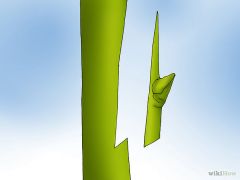
|
|
|
side graft |
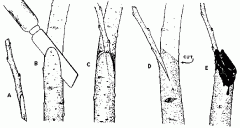
|
|
|
cleft graft |
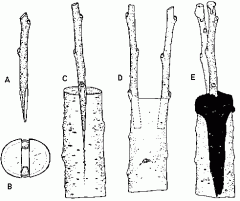
|
|
|
inarching |
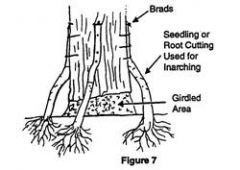
|
|
|
inverted T-bud |
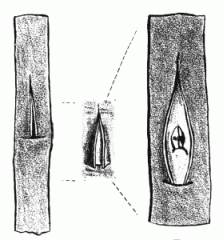
|

